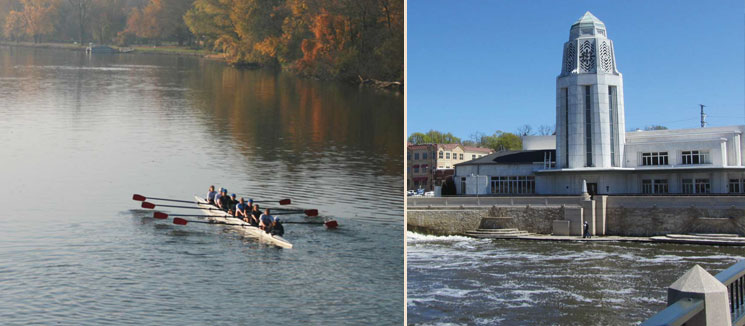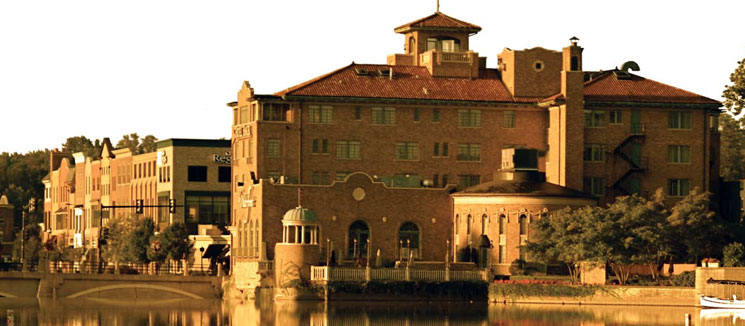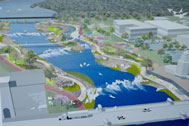
Master Plan
Executive Summary

Dear Community Leaders:
From the time that St. Charles was first settled, the Fox River has been one of its most important assets. Today, thanks to the vision of past leaders who recognized the importance of the river, St. Charles prospers and enjoys a sparkling regional reputation. The future of the Fox River and riverfront in St. Charles is extraordinary. Actively nurtured, the river corridor will feature a compelling package of natural and man-made assets that will defi ne the community’s environmental, cultural and economic prosperity for decades to come.
Building on a tradition of visionary planning, the 2002 River Corridor Master Plan illustrated the community’s concept of a signature riverwalk along both sides of the river that would attract visitors, connect parks and neighborhoods to downtown, and stimulate downtown investment. The plan also recommended design guidelines and described an incremental implementation process. Spearheaded by the St. Charles River Corridor Foundation, the City of St. Charles and the St. Charles Park District have completed some key projects including the riverwalk between Prairie and Illinois Streets along the west bank of the river, named in honor of the late Bob Leonard, the 2002 Downtown St. Charles Partnership River Corridor Committee co-chairman. However, many of the master planned projects remain unrealized.
In 2015, led by the Active River Task Force of the River Corridor Foundation, the City of St. Charles, the St. Charles Park District and the Forest Preserve District of Kane County sponsored this master plan update. Consistent with the 2002 master planning process, the consultant team analyzed the multitude of existing resources and intriguing market conditions, and gathered valuable input from residents and dozens of civic, jurisdictional, business and special interest organizations. In addition, the team gave extra attention to the multi-dimensional characteristics of the river. This 2015 update describes the Exceptional Opportunity, Active River Strategy and Incremental Implementation Process that will enable the community to realize its goal to “create a lively riverfront environment that is the centerpiece of the community.”

- Exceptional Opportunity
- Active River Strategy
- Incremental Implementation Process
- Policy Improvements
- Capital Improvements
- Operational improvements
Exceptional Opportunity
Clearly, St. Charles is not the only town in the region with a downtown river. Every Fox River Valley town was settled along the river, and many other towns in the region have rivers fl owing through their downtown. Some towns have begun to reverse decades of riverfront neglect caused by industrialization and cyclical fl ooding issues in order to leverage their riverfronts as recreational and cultural assets. Regionally, downtown Naperville has built its brand, in part, on the success of its riverwalk, and Chicago recently opened the fi rst phase of its $43 million Riverwalk. Nationally, countless communities have turned to their rivers to reinvigorate their downtowns. Four example communities are referenced in this plan. What, then, sets St. Charles apart from the crowd? As summarized in the Opportunity Analysis, the Fox River Corridor in St. Charles has an exceptional combination of desirable resources, attractive markets and market trends, and engaged stakeholders; all of which set the stage for success.
Almost four miles long, the St. Charles reach of the Fox River is uncommonly scenic, with much of the shoreline, particularly north and south of downtown, in public ownership and attractively improved for recreation. The impounded pool upstream of the dam is a beautiful and treasured asset for rowing and motorboat enthusiasts, and the Fox River Trail is an enormously successful regional bike trail that draws thousands to the vicinity. In addition to iconic commercial properties like the Baker Hotel, the 2013 Comprehensive Plan identifi ed many properties, small and large, that could be redeveloped to take advantage of the river and riverfront improvements.
The local market is affl uent and aging, with many more single adult and empty-nester households forecasted. Nationally and regionally those populations, along with the younger adults, are often seeking active urban and suburban lifestyles that support walking, cycling, canoeing, kayaking and rowing activities. St. Charles’ domination of the local hotel market makes for an especially intriguing opportunity on the riverfront.
As can be expected, diverse Fox River Corridor stakeholders often have confl icting interests, but everyone seems to agree on the importance of the river and the need to manage it with great care. What, if anything, to do with the dam seems to be the topic that crystallizes the recreation vs. preservation, activation vs. restoration, and even old vs. new differences among those who love the river and their community. This debate is particularly important to the Fox River Study Group (FRSG), which includes representatives from state regulatory agencies, the City of St. Charles and other Fox River communities. The FRSG was formed to develop data-supported water quality recommendations for the Fox River, focusing primarily on discharge from sewage treatment plants, in lieu of an IEPA mandated phosphorous Total Maximum Daily Load requirement. The FRSG has studied the potential benefi ts of dam removal as one option to improve water quality of the Fox River. Dam removal proponents argue that the IDNR has indicated a willingness to contribute as much as $2.5 million to remove the dam and that a complete removal of the dam will improve water quality and supplement the need for sewage treatment plant modifi cations. By comparison, dam retention advocates suggest that the current upstream pool is a priceless community asset and cannot be altered.
Given the abundant opportunities and daunting challenges, how can St. Charles best capitalize on its remarkable assets and attractive markets to distinguish itself in the Fox River Valley and achieve the community’s heartfelt goal to be the centerpiece?
Active River Strategy
The City of St. Charles, the St. Charles Park District, the Forest Preserve District of Kane County, business owners, property owners and all other partners who love this important river corridor need to embrace a longterm, multi-dimensional strategy to complete a package of seasonal and year-round river-centric attractions and complementary destinations; complete the river, riverwalk and trail connections; embellish the natural, cultural and recreational assets, refi ne and align brand communications; and act systematically and incrementally to gain and sustain momentum.
Each one of these fi ve strategic dimensions supports and builds on existing assets, past achievements and important recommendations from the 2002 master plan. For instance, this 2015 Fox River Corridor Master Plan reinforces the need to complete a barrier-free, signature riverwalk and to improve and extend the Fox River and Great Western Trails. Both the riverwalk and trail improvements advance four strategic dimensions, simultaneously, as branddefi ning magnet attractions, valuable connections and cultural/recreational assets.
Another brand-defi ning attraction, the spectacular multi-dimensional “River Park” featured in this 2015 update extends from Main Street to the railroad trestle along both sides of the river. River Park includes an expansive riverwalk, barrier-free trail extensions, a nature-based children’s play environment, naturalized shorelines, exciting pedestrian bridges, and a paddling course – all made possible by a major dam modifi cation that is conceived to maintain the slow-moving, fl at-water surface of the upstream impoundment that is ideal for rowing and power boating while creating a narrower, more natural, stepped river channel that allows wildlife passage and accommodates canoeists, kayakers and other river enthusiasts of all skill levels. In fact, River Park creates a connection between downtown and Pottawatomie Park and also creates an unmatched catalyst for the substantial redevelopment of relatively large tracts both east and west of the river.
Closely related ecological and infrastructure improvements at Boy Scout Island will improve water quality, wildlife habitat and boat launching while creating a distinctive water garden opportunity. Grade-separated and safer atgrade crossings will improve pedestrian and cyclist access to and along the riverfront, and dozens of smaller scale projects will embellish the natural, cultural and recreational features that will strengthen and defi ne the St. Charles riverfront brand. In addition, all of the river and riverfront amenities will help attract much-needed smaller-scale residential, offi ce and restaurant infi ll development. They will also promote private sector investment in seasonal recreation activities such as camping, cycling, boating, climbing and ropes courses.
This Active River Strategy will elevate St. Charles’ brand from good to great. When fully realized, the St. Charles river corridor will boast a package of extraordinary natural, cultural and recreational attractions, complimentary commercial and residential destinations, and vital connections that will appeal to an active and growing regional population. Other river towns may have some of these amenities, but St. Charles can have the most. Along the way, the river corridor partners – and the City of St. Charles, in particular, should craft a coordinated brand platform and communications around the river and the complete riverfront package.
The last dimension of the Active River Strategy, gaining and sustaining momentum, may be the most daunting. Like the 2002 plan, this update comes on the heels of a severe recession, and is compounded by unprecedented fi nancial problems at the State of Illinois. Nonetheless, the long-term benefi ts are clear and compelling, the public is enthusiastic, and the process, when subdivided into small components, is manageable.
Incremental Implementation Process
Led by the City of St. Charles, the river corridor partners should all adopt this plan and commit to incremental implementation of the Active River Strategy by systematically executing a series of correlated policy, capital and operational improvements. The City and its river corridor partners should, initially, concentrate on key public policies that will set the stage for future work, vigorously promote the strategy to all stakeholders, and coordinate public and private sector capital improvements-in-progress to align with the updated master plan.
Policy Improvements
- Vigorously advocate the Active River Strategy with the FRSG to promote consideration of ecological, water quality and habitat improvements to supplement and off set conventional treatment plant improvements in their upcoming Fox River Improvement Plan that supports the “River Park” concept in this plan.
- Select river corridor improvements, including the Phase I study of the dam modifi cation, for the 2016 and the 3 year Capital Improvement Plans (approx. $4.1M).
- Seek funding through state and federal sources to complete the Phase I study of the dam modifi cation. Confi rm local match requirements.
- Assign someone to research grant funding and produce periodic memoranda to be shared and compared with other corridor partners. Identify the best opportunities and partnerships, and apply for/facilitate grant awards.
- Complete the Police Facility Study and determine the availability of this important site for redevelopment.
Capital Improvements
- Align the Piano Factory Bridge rehabilitation, temporary city hall/police station bulkhead wall rehabilitation, and Fox River Trail sign improvement projects-in-process with the Active River Strategy.
- Align the First Street redevelopment project-in-process with the Active River Strategy.
- Commence the Preliminary Design/Engineering study of the dam modifi cation (approx. $1M).
- Complete the Preliminary Design/Engineering of the Riverside Drive Riverwalk (approx. $50K).
- Complete the Preliminary Design/Engineering of selected shoreline improvements and Leonard Memorial Walkway pedestrian amenities and enhancements (approx. $25K).
Operational improvements
- Synchronize the 2016 City, Park District and County operational plans with other river corridor partners to prioritize the Active River Strategy.
- Continue to actively communicate and promote the Active River Strategy with all jurisdictional, organizational, commercial and residential stakeholders.
Timely community action is critical because the FRSG’s Fox River Improvement Plan is due to be released at the end of 2015. Given the circumstances, if FRSG supports the Active River Strategy, then St. Charles is in a better position to obtain IDNR funding support for a dam modifi cation.
 The goal of the St. Charles Active River Project is to create a lively riverfront environment and experience that is the centerpiece of the community.
The goal of the St. Charles Active River Project is to create a lively riverfront environment and experience that is the centerpiece of the community.